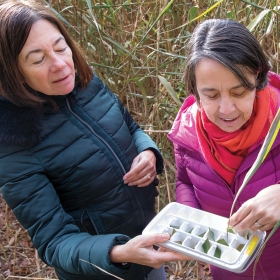“The big, ambitious question is to try to understand the fundamental traits related to invasion success. But our more specific, tangible goal was to understand what varieties of phragmites are present on campus.”

Königer and Professor Andrea Sequeira examine the reeds in a wet meadow on campus.
Phragmites, a common reed, has grown in New England for hundreds of years. The proliferation of non-native varieties on the Wellesley campus is more recent, however. Andrea Sequeira, Gordon P. Lang and Althea P. Lang ’26 Professor of Biological Sciences, and Martina Königer, adjunct assistant professor of biological sciences, have been studying the wet meadows on campus where phragmites have become dominant, using an interdisciplinary lens of population genetics and physiology.
“There is a native variety [of phragmites] in this area,” says Königer. “We’re not totally sure when the invasion of the non-natives started, but probably around 70 years ago. It’s a variety that originated in Eurasia, and probably was brought over in ships in the ballast. And it is a cryptic invasion, which means that people didn’t even notice that there was a different variety around, because the native and the introduced look extremely similar to each other.”
It took genetic analysis to figure out that the spreading, fluffy reeds on campus were different varieties than the native plant and ecological and physiological analysis to understand their role in the ecosystem and the details behind their resilience.
The biologists are fairly sure that the extensive stand of phragmites in the meadow beside the Science Complex has been there since the ’80s, based on recollections of ecologists working on campus at the time.
Königer and Sequeira studied three sites: the Science Complex meadow, and two sides of the boardwalk near Paintshop Pond. “In 2003, when [remediation of Paintshop Pond] was finished, the area had been planted with native species,” says Königer. “It was fine for a little bit, and then loosestrife came in. Then phragmites came in. So the invasion there probably occurred in the late 2000s.”
The wet meadows project was funded by a grant from the Paulson Ecology of Place Initiative, and considers questions that are at the intersection of several different disciplines—ecology, physiology, genetics, and invasion biology.
“The big, ambitious question is to try to understand the fundamental traits related to invasion success,” says Sequeira. “But our more specific, tangible goal was to understand what varieties of phragmites are present on campus. We didn’t know if we had the native or the invasive, or where they came from.”
“We collected information on about 20 different variables—a truckload of data.”
With the assistance of some 20 students, including two working on theses, they measured and collected samples from 10 plants on each of the sites multiple times during two seasons. “That’s lots of field hours,” Königer says. “We collected information on about 20 different variables—a truckload of data. We have physiological traits. We have growth data, information on the insects, spiders, and the plant community.”
Genetic results indicate that the phragmites from the different campus areas originated from two genetically distinct sources. “The ones from the sites closer to Paintshop Pond and the boardwalk have a different geographic source than the one in the wet meadow,” says Königer. “We have learned that all the phragmites stands on campus are of the invasive variety. There are none of the native varieties on our campus.”
Königer explains that their ecological and physiological studies indicate that the reed stands are extremely resistant to stress and can harbor a large variety of insects and spiders without major detriment to their survival. However, the presence of particular plant competitors may slow their invasion success.
The scientists are hoping their work will broaden the understanding of the prolific plant. “Because it can grow so tall, it can have a positive role as a wetland inhabitant,” Königer explains. “It can help with carbon sequestration, grabbing carbon dioxide, which is a greenhouse gas. As a larger plant with deeper roots, it has been calculated that in some environments, phragmites can take up to three times as much carbon as the native plants. It also takes up nitrogen and phosphorus, and heavy metals. Some of the work that we have done could inform wetland management or restoration efforts.”
The colleagues are currently working on publications associated with the study.
[substory:1]